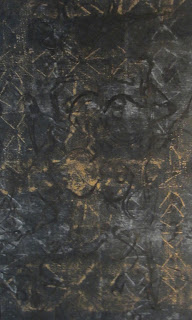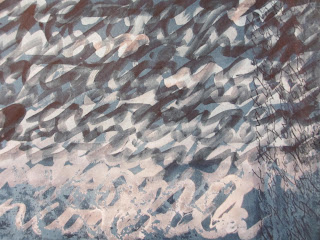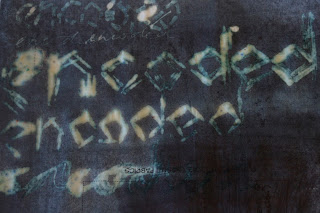I was very disappointed with the run of samples 4:2:9 - 4:2:12, feeling they were hardly worth posting. I'm not quite sure why this works but tidying my stuff, dusting and hoovering my workroom has helped me start again. Maybe it was also having firm words with myself. Anyhow, today I set about producing a new set of samples.
So what I've done is review last session's work and pick out what I liked, which were the very angular letters and look for a different tool to work with. I found a bag of corrugated card in various grades and used both cut and torn edges to apply black ink. I found quite a lot to like: the double line, both with a crinkly edge and more appealing still a sort of stitched mark. Example 7 was just a single tube of the card. My favourite was example 6, printed with a curved piece of card, forming each letter needed careful thought.
 |
| 4:2:19 |
And now for bleach marks on Brusho, using the same tool, possibly there's some potential here though I'm not sure.
 |
| 4:2:20 |
In 4:2:21 I've used the print sample 6 and created an allover pattern by working it continuously.
 |
| 4:2:21 |
Below are examples of lettering which has been layered onto 4:2:21. Immediately below strips of crisp white tissue paper, which were first written on repeatedly with brush pen, allowing the ink to run out, have been cut and placed diagonally across the first layer. The first layer can be seen through the tissue.
 |
| 4:2:22 |
In the following two examples a crayon rubbing of an individual PVA word has been cut in half lengthways and overlaid on the first layer. This time the paper used was 40g Mitsumata Washi which as well as being transparent is closer in colour to the first layer. The abstract marks also seem to have something in common so that accents and areas of density are created.
 |
| 4:2:23 |
 |
| 4:2:24 |
Reviewing today's work, I feel better pleased. It is a relief to feel I have a sense of direction, but these results seem too rigid. I'd like to apply layers more directly. The samples below show layers of rubbings on black tissue which is thin and soft and takes rubbings well. On it I've used a variety of materials: wax crayon, pastels, chalk, Woody etc.
Two sorts of rubbing boards have been used for the three samples below: the word "encoded" stitched in string on canvas -- different thicknesses of string for different sized lettering. I also wrote the word encoded in thick PVA glue. These letters became very blurred as they dried but were an ideal when applied in black wax. I particularly liked the black on black effect as it breaks up some of the uniform and opaque appearance of the black tissue. It also adds depth.
In sample 4:2:27 the tissue was marked with bleached first with chalk and pastel string rubbings on top.
 |
| 4:2:25 |
 |
| 4:2:26 |
 |
| 4:2:27 |
Now for two samples, 4:2:28 and 4:2:29. In these white candle wax has been used as a resist. The paper has then been flooded with dilute Brusho, revealing the letters and creating a patchy background. Finally handwriting has been applied with a thick graphitint. A final black wax rubbing has been applied to 4:2:29.
 |
| 4:2:28 |
 |
| 4:2:29 |
In sample 4:2:30 a Brushoed sheet has been printed all over with a corrugated card edge, then turned at right angles and "encode" written on it in gold Woody. An attempt to add gold rubbings is disappointing. The thicker paper does not respond to the technique as well as tissue.
 |
| 4:2:30 |
Back to thin paper in 4:2:31, his time the Mitsumata Washi. Whilst it takes rubbings it's really not strong enough and the addition of a wash causes it to tear. In 4:2;32 two rubbings have been applied over each other on thicker paper.
 |
| 4:2:31 |
 |
| 4:2:32 |
I like the delicate markings of 4:2:31 so I take a PVC rubbing board with the word "encode" on it, cut it vertically and then reassemble it. The delicate marks are made in candle wax over-painted with dilute Brusho.
 |
| 4:2:33 |
 |
| 4:2:34 |
A return to the ideas in 4:2:17, but this time black ink and bleach have been applied to a Brusho wash. Further writing has been applied at right angles.






















